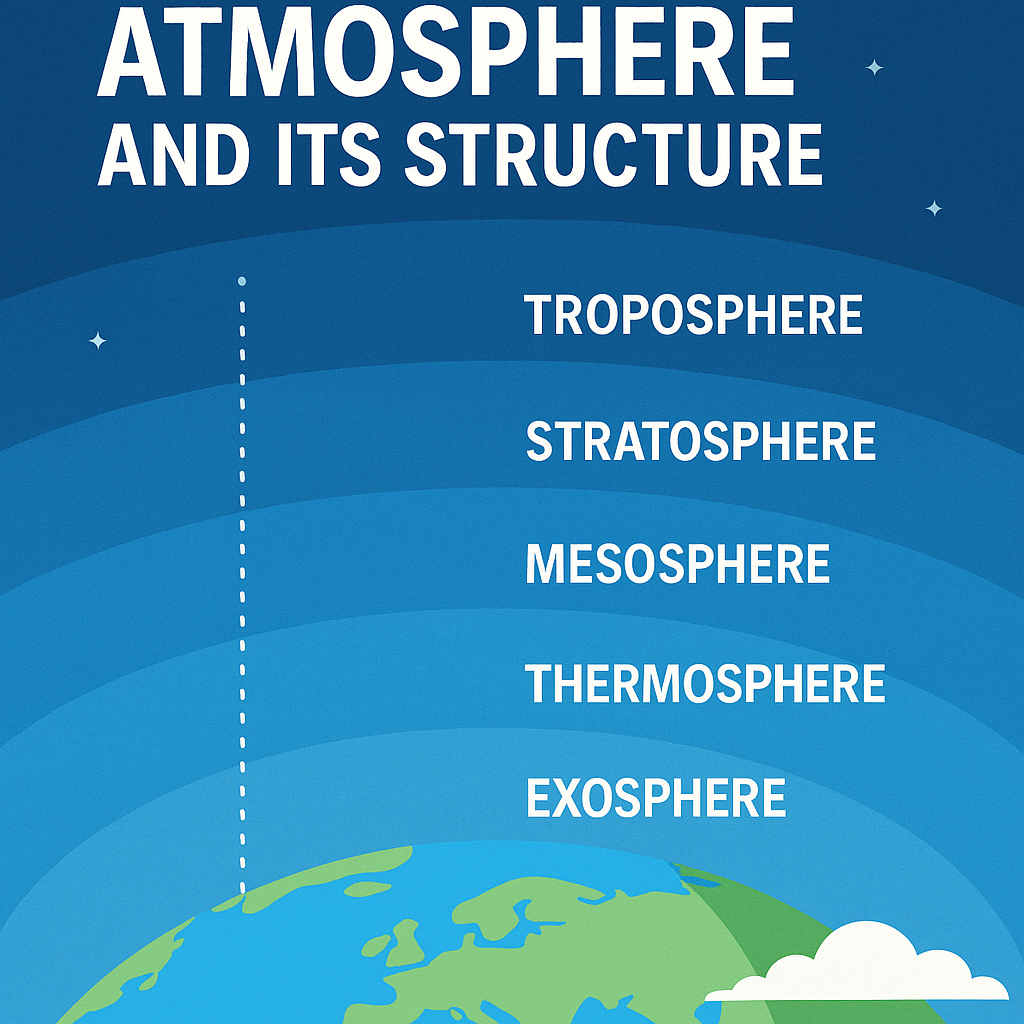Atmosphere and Its Structure
What is Atmosphere?
The atmosphere is the thin layer of gases that surrounds the Earth, held close by the planet’s gravitational pull. It is an essential part of the Earth system, providing the air we breathe, protecting life from harmful solar radiation, and playing a crucial role in weather, climate, and the water cycle. Without the atmosphere, Earth would be an inhospitable place, with extreme temperatures and no protection against space debris or ultraviolet rays from the sun.
Composition of the Atmosphere
The atmosphere is primarily composed of nitrogen (about 78%) and oxygen (about 21%), with small amounts of other gases such as argon (0.93%), carbon dioxide (around 0.04%), neon, helium, methane, krypton, and hydrogen. Water vapor is also a variable but important component, making up to 4% of the atmosphere in humid regions. This mixture of gases is vital for respiration, photosynthesis, and maintaining the Earth’s energy balance.
Structure of the Atmosphere
The atmosphere is divided into five main layers based on temperature changes with altitude. These layers differ in their composition, temperature, and density:
1. Troposphere
- Altitude: From the Earth's surface up to approximately 8 to 15 kilometers (5 to 9 miles), depending on the location (lower near the poles and higher near the equator).
- Characteristics: Contains about 75% of the total mass of the atmosphere and almost all the water vapor and aerosols, making it the layer where weather occurs — clouds, rain, storms, and winds all take place here.
- Temperature: Decreases with altitude at an average rate of about 6.5°C per kilometer.
- Importance: The layer humans live in and where airplanes typically fly.
2. Stratosphere
- Altitude: Extends from the top of the troposphere to about 50 kilometers (31 miles) above the Earth's surface.
- Characteristics: Contains the ozone layer, which absorbs and scatters ultraviolet (UV) radiation from the sun, protecting living organisms from harmful UV rays.
- Temperature: Increases with altitude because ozone absorbs UV radiation.
- Importance: Stable air allows some aircraft, like commercial jets and weather balloons, to operate here.
3. Mesosphere
- Altitude: From about 50 kilometers up to 85 kilometers (31 to 53 miles).
- Characteristics: Coldest layer of the atmosphere, temperatures can fall as low as -90°C (-130°F).
- Temperature: Decreases with altitude.
- Importance: Most meteors burn up in this layer due to friction with air molecules.
4. Thermosphere
- Altitude: Ranges from 85 kilometers to around 600 kilometers (53 to 373 miles).
- Characteristics: Very thin air; molecules absorb intense solar radiation causing high temperatures (up to 2,500°C or more).
- Temperature: Increases rapidly with altitude.
- Importance: Contains the ionosphere, important for radio communication and auroras.
5. Exosphere
- Altitude: Extends from about 600 kilometers above Earth to beyond 10,000 kilometers (373 miles to over 6,200 miles).
- Characteristics: Outermost layer where atmospheric particles gradually escape into space.
- Temperature: Remains high but feels cold due to very low density.
- Importance: Fades into outer space; satellites orbit here.
Importance of the Atmosphere
The atmosphere is critical to sustaining life on Earth. It provides oxygen for respiration and carbon dioxide for photosynthesis. It regulates temperature by trapping heat through the greenhouse effect, ensuring Earth is warm enough to support life but not too hot. The atmosphere also plays a vital role in the water cycle, enabling evaporation, cloud formation, and precipitation.
Furthermore, the atmosphere protects Earth from space hazards like meteoroids, which usually burn up before reaching the surface. It also shields organisms from harmful solar radiation, especially ultraviolet rays, through the ozone layer.
Summary
In brief, the atmosphere is a complex, multilayered envelope of gases surrounding Earth. Each layer — the troposphere, stratosphere, mesosphere, thermosphere, and exosphere — has unique characteristics and functions that together maintain the delicate balance necessary for life. Understanding the atmosphere helps us comprehend weather patterns, climate change, and the impact of human activities on our environment.
